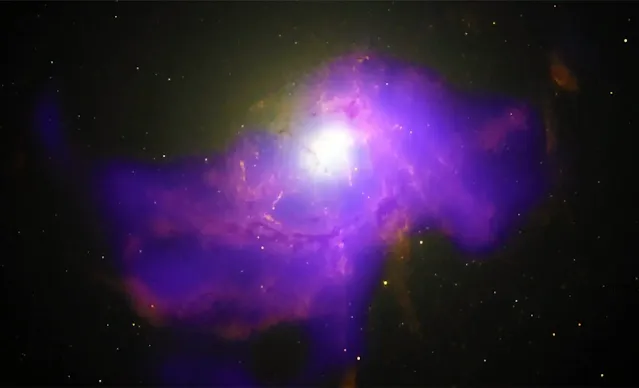Black Holes: Catalysts of Their Own Sustenance
Black holes, the enigmatic titans of the cosmos, have long been perceived as passive consumers, devouring any matter that strays too close. Recent studies, however, have unveiled a more dynamic role: black holes actively influence their surroundings to facilitate their own nourishment. This article delves into the mechanisms by which black holes orchestrate the cooling of surrounding hot gas, leading to the formation of filaments that channel material directly into their grasp.
The Self-Sustaining Cycle of Black Hole Feeding
Outbursts and Gas Cooling
At the centers of galaxy clusters, supermassive black holes emit powerful jets and outbursts. These energetic emissions, rather than merely expelling matter, play a pivotal role in cooling the surrounding hot gas. The process unfolds as follows:
- Jet Emission: The black hole releases high-energy jets into the surrounding medium.
- Induced Turbulence: These jets stir the hot gas, creating turbulence.
- Cooling and Condensation: The turbulence facilitates the cooling of hot gas, leading to its condensation into narrower, cooler filaments.
This sequence establishes a feedback loop where the black hole's activity directly contributes to the creation of structures that feed it.
Formation of Gas Filaments
The cooled gas condenses into filamentous structures that extend toward the black hole. These filaments serve as conduits, channeling material from the outer regions of the galaxy cluster directly into the black hole's vicinity. Observations from instruments like NASA's Chandra X-ray Observatory and the Very Large Telescope (VLT) have provided visual evidence of these filaments in clusters such as Perseus and Centaurus. In these observations:
- X-ray Data (Chandra): Reveals hot gas structures.
- Optical Data (VLT): Highlights cooler gas filaments.
The juxtaposition of these data sets illustrates the transition from hot gas to cooler filaments, underscoring the black hole's role in this transformative process.
Continuous Feedback Loop
Once the filaments deliver material to the black hole, the infalling gas triggers further outbursts, perpetuating the cycle. This self-regulating mechanism ensures a steady supply of fuel for the black hole, maintaining its growth and activity over cosmic timescales.
Implications for Galactic Evolution
Star Formation
The cooling of gas and formation of filaments have significant implications beyond black hole feeding. Some of the cooled gas does not get consumed by the black hole but instead contributes to star formation. This process enriches the galaxy cluster with new stars, highlighting the black hole's indirect role in seeding stellar genesis.
Energy Distribution in Galaxy Clusters
The outbursts from black holes distribute energy throughout the galaxy cluster, influencing the thermal state of the intrici luster medium. This energy distribution affects the rate of gas cooling and, consequently, the dynamics of galaxy evolution within the cluster.
Conclusion
The discovery that black holes can catalyze the cooling of surrounding gas to create their own sustenance marks a significant advancement in our understanding of these cosmic entities. This self-sustaining feeding mechanism not only highlights the active role black holes play in their own growth but also underscores their influence on the broader galactic environment, including star formation and energy distribution within galaxy clusters. As research progresses, these insights will continue to refine our comprehension of the intricate dance between black holes and the cosmos they inhabit.




0 Comments